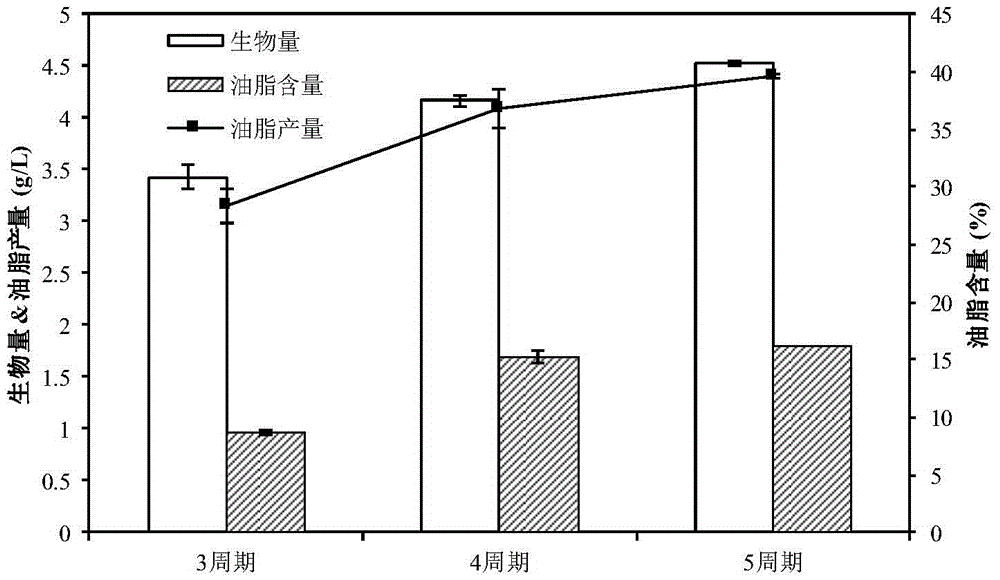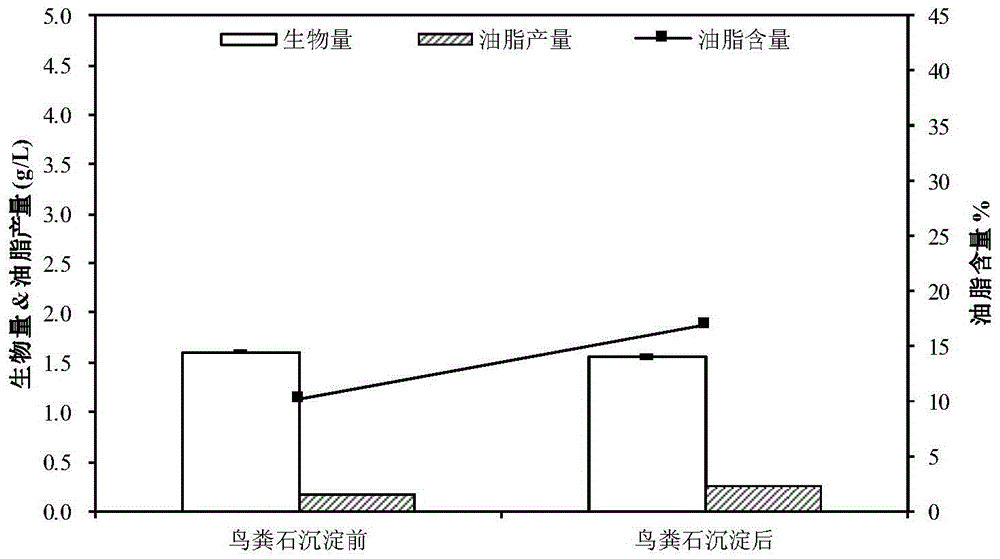Method for producing acid by fermenting excess sludge and synthesizing microbial oil
A microbial oil and excess sludge technology, applied in the direction of microorganism-based methods, biochemical equipment and methods, microorganisms, etc., can solve the problems of low oil production, release and existing forms that are not suitable for yeast to use, and poor effects, etc., to achieve Low production cost and remarkable effect of promoting production
- Summary
- Abstract
- Description
- Claims
- Application Information
AI Technical Summary
Problems solved by technology
Method used
Image
Examples
Embodiment 1
[0032] (1) Anaerobic fermentation: Settling the remaining sludge at 4°C for 12-24 hours until the concentration of the concentrated sludge in the lower layer is between 15-20g / L, remove the supernatant, and take 300mL of concentrated sludge to 1L In an anaerobic fermentation tank with a volume of 0.1g / gTSS, add tea saponin at a concentration of 0.1g / gTSS, and carry out anaerobic fermentation of sludge under anaerobic conditions. The time is 7 days. The method of solid-liquid separation of the fermentation broth is centrifugation, the centrifugal force of the centrifugation is 10000×g, and the centrifugation time is 20 minutes to obtain the acid-producing supernatant.
[0033] (2) Removal of ammonia nitrogen in the supernatant: collect the acid-producing clear liquid obtained from the anaerobic fermentation of the sludge, and take an appropriate amount of the supernatant from the sludge fermentation, according to N:P:Mg(mol:mol:mol)=1:2.2: 2.2 Add a specified amount of disodiu...
Embodiment 2
[0044] (1) Anaerobic fermentation: Settling the remaining sludge at 4°C for 12-24 hours until the concentration of the concentrated sludge in the lower layer is between 15-20g / L, remove the supernatant, and take 300mL of concentrated sludge to 1L In an anaerobic fermentation tank with a volume of 0.1g / gTSS, add tea saponin at a concentration of 0.1g / gTSS, and carry out anaerobic fermentation of sludge under anaerobic conditions. The time is 7 days. The method of solid-liquid separation of the fermentation broth is centrifugation, the centrifugal force of the centrifugation is 10000×g, and the centrifugation time is 20 minutes to obtain the acid-producing supernatant.
[0045] (2) Removal of ammonia nitrogen in the supernatant: collect the acid-producing clear liquid obtained from the anaerobic fermentation of the sludge, take an appropriate amount of the supernatant from the sludge fermentation, and add it according to N:P:Mg(mol:mol)=1:2.2:2.2 A specified amount of disodium ...
Embodiment 3
[0056] (1) Anaerobic fermentation: Settling the remaining sludge at 4°C for 12-24 hours until the concentration of the concentrated sludge in the lower layer is between 15-20g / L, remove the supernatant, and take 300mL of concentrated sludge to 1L In an anaerobic fermentation tank with a volume of 0.1g / gTSS, add tea saponin at a concentration of 0.1g / gTSS, and carry out anaerobic fermentation of sludge under anaerobic conditions. The time is 7 days. The method of solid-liquid separation of the fermentation broth is centrifugation, the centrifugal force of the centrifugation is 10000×g, and the centrifugation time is 20 minutes to obtain the acid-producing supernatant.
[0057] (2) Removal of ammonia nitrogen in the supernatant: collect the acid-producing clear liquid obtained from the anaerobic fermentation of the sludge, take an appropriate amount of the supernatant from the sludge fermentation, and add it according to N:P:Mg(mol:mol)=1:2.2:2.2 A specified amount of disodium ...
PUM
| Property | Measurement | Unit |
|---|---|---|
| quality score | aaaaa | aaaaa |
Abstract
Description
Claims
Application Information
 Login to View More
Login to View More - R&D Engineer
- R&D Manager
- IP Professional
- Industry Leading Data Capabilities
- Powerful AI technology
- Patent DNA Extraction
Browse by: Latest US Patents, China's latest patents, Technical Efficacy Thesaurus, Application Domain, Technology Topic, Popular Technical Reports.
© 2024 PatSnap. All rights reserved.Legal|Privacy policy|Modern Slavery Act Transparency Statement|Sitemap|About US| Contact US: help@patsnap.com









